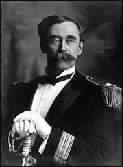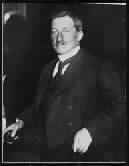 |
 |
 |
 |
 |
|
|
|
 |
 |
 |
| In September of 1909, an American medical doctor and veteran of both arctic and antarctic travel, Frederick A. Cook, astonished the world with the news that he and two Eskimo companions had reached the North Geographic Pole on April 21, 1908. A break-up of ice in the summer of 1908 had prevented his return to land and had forced him and his two companions to over-winter in a remote area to the south. This, he said, had delayed his return to civilization by a year. |
| Five days later, another veteran arctic traveler and a Navy civil engineer, Robert E. Peary, announced that he and five companions had reached the North Pole on April 6-7, 1909 and labeled Cook a fake. "Dr. Cook has handed the public a 'gold brick,'" Peary wired in a widely publicized message from Battle Harbor, Labrador, on his return from the Arctic. Although the laurels ultimately went to Peary, doubts still linger and, despite protestations of countless writers on the subject that they have had the final word, it is unlikely the debate will ever be definitively resolved. In fact, one of the more intriguing aspects of the Cook-Peary controversy is that of how, ninety years later, the debate could still have the capacity to fascinate--and infuriate--so many partisans on both sides. |
| Christmas traditions notwithstanding, there is nothing at the North Pole and no real reason why anyone should want to go there--other than, like Mt. Everest, It's there! In contrast to the antarctic landmass in the southern hemisphere, a continent roughly the size of the United States and Mexico combined, the north polar region is a vast sea perpetually covered by floating ice. Since the polar ice pack is constantly in motion moved by wind and currents, there is no permanent means to mark the location of the North Geographic Pole. Yet few points on earth have held out such lure...or been the subject of so much mystery and bitter controversy. |
| At first Cook was feted in both Europe and the United States as the discoverer of the North Pole and Peary's claim of reaching the North Pole, that came a year later than Cook's although both were announced within a week of each other, was largely ignored or not believed. Soon, however, Peary supporters began raising questions about Cook's proof of reaching the pole--although Peary's "proof" was never any better--and doubts about Cook's veracity, particularly his claim of having reached the summit of Mt. McKinley in Alaska in 1906, began to creep in. Cook had sold his account of the polar journey to the New York Herald while Peary's account appeared in the then-struggling New York Times. Within weeks, the debate became a war of words between the two rival newspapers that countless numbers of eager readers followed daily. |
| In a series of bitter attacks that would rival any present-day political campaign, Peary supporters questioned Cook's abilities, his veracity and even his sanity. Cook failed to respond and ultimately left the country--a move Peary supporters interpreted as "fleeing the country" because his claims were false--and public opinion soon shifted in Peary's favor. Taking advantage of this shift in public sentiment, Peary submitted his north pole data to the National Geographic Society. After what was disclosed in congressional hearings a year later to have been little more than a cursory glance, the NGS "certified" Peary as the discoverer of the North Pole. However, the group never investigated Cook's claim. If Cook had in fact reached the pole a year earlier, it would be irrelevant in terms of firsts or discoveries if Peary had reached the pole in 1909. |
| Acting on the quasi-official acceptance of Peary's claim, his supporters next turned to having Peary promoted to a Navy Admiral and retired with a pension. But far from the automatic action that they may have anticipated, this move touched off a series of events that continue to this day. |
| The so-called Peary Hearings in congress in 1910-11 again raised the question of Peary's "proofs" (or lack thereof) of reaching the North Pole. Although Congress ultimately promoted Peary to Rear Admiral and retired him with a pension, they took no official action to declare him the discoverer of the North Pole. |
| Peary died in 1920 prompting widespread fears among his supporters that Cook would use Peary's demise as an opportunity to press his claim. However, during the 1920s Cook had turned to oil prospecting and appeared to be uninterested in the north pole controversy. Nevertheless, in 1924 Cook was convicted on a somewhat questionable charge of mail fraud in the promotion of oil stocks and sentenced to Leavenworth prison. Cook is reported to have been a model prisoner at Leavenworth, and during this time, with the help of a small but loyal group of supporters, once again began pressing his north pole claim. |
| Cook was finally released from Leavenworth in 1930, penniless and in poor health, after having served an inordinately long sentence considering the crime for which he was convicted. Cook died of a stroke in 1940 shortly after having been granted a full pardon by President Roosevelt. But still the debate did not die with Cook's death. |
| There was a brief lull in the controversy during the war years, but following World War II a small group of Cook family members and other supporters continued to keep Cook's name alive. In 1951, one of the most starkly and strikingly beautiful books on the Arctic, Cook's Return from the Pole, appeared. The book, edited by historian Frederick J. Pohl, was based on Cook's notes from the year spent returning the point he believed, or claimed, was the North Pole, over-wintering in a cave in the remote Devon Island district of the Canadian Arctic, and finally returning in April 1909 to his base in northwest Greenland. This was followed in 1961 by Andrew Freeman's The Case for Doctor Cook, a biography based on notes notes from interviews with Cook in the 1930s. Meanwhile, the Peary family and the National Geographic Society continued to support Peary's claim and every school-child learned from his or her history books and encyclopedias that Peary discovered the North Pole. |
 |
|



